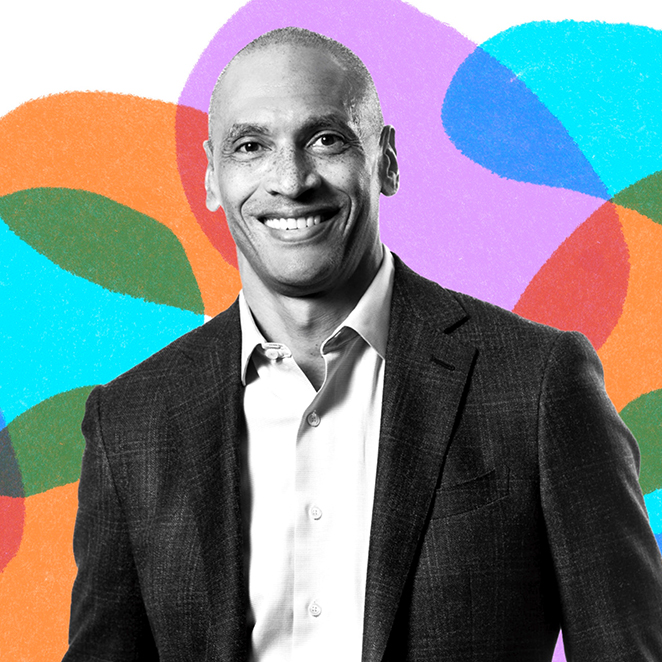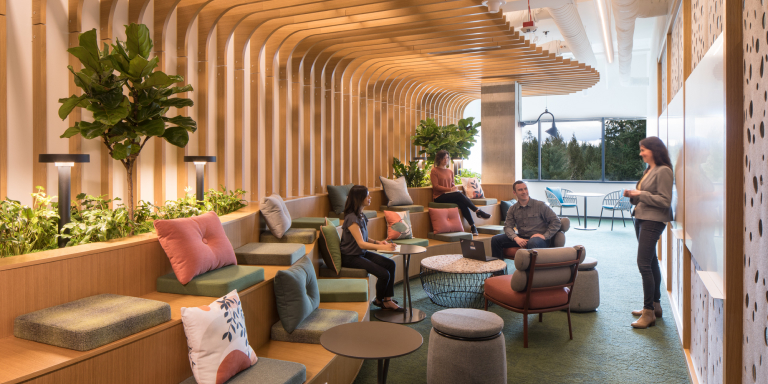You could say that Chris Young sees the future. As executive vice president of business development, strategy, and ventures at Microsoft, he’s tasked with thinking about where the company is headed and making the strategic decisions to help it get there. Within his purview: assessing market opportunities and new businesses; overseeing M12, the company’s venture investing group; and blockbuster alliances such as the recently announced partnership with Netflix , which will power the streaming service’s new ad-supported subscription offering.
He’s long had an eye for what’s next. In the nineties, he founded a start-up in the nascent internet security industry before the term “cybersecurity” had even been coined. Later, he became the CEO of antivirus software giant McAfee, spearheading the company’s spin-off from Intel in 2017. He joined Microsoft in November 2020, in the thick of pandemic-prompted remote work. Onboarding virtually gave him unique insight into this new way of working—and how to make it as inclusive an experience as possible.
Here, Young shares his point of view on what work will look like in the future, from how we’ll interact with artificial intelligence to how we can lead through times of uncertainty.
You’re based in the Bay Area. What was it like to join Microsoft virtually?
For the first several months of my time here, all of my interactions with other people from Microsoft and partners and customers were virtual. Since then, I’ve gotten into a cadence of spending intentional time in Redmond, Washington, at Microsoft’s headquarters. I’m intentional about letting people know when I’m going to be there. We try to schedule time together. We’ve done small social gatherings. I want to make sure I use that as an opportunity to communicate, interact, socialize—get to know everyone a little bit better.
Because I will tell you, that last element has been one of the hardest parts of joining a company during the pandemic. You really do miss out on the ability to connect with people on a more personal level. We’ve all tried to bridge some of that with things like virtual coffee chats. But the reality is, those haven’t fully substituted for the informal human interactions that we have with one another. Knowing each other as human beings is a really important part of working well together.
What advice would you give leaders for making sure that people who are distributed really feel like a part of a cohesive team?
Being intentional about when you get people together is really important. Leaders and managers are going to have to think a little bit more about, “Okay, when do I bring people together? What am I bringing them together for? What’s my agenda? What do I want to get out of this?” As opposed to just getting people together because, hey, we have a staff meeting every week, and so therefore we’re going to all meet every week. In some ways, this intentionality is forcing a different hygiene in terms of how we interact with one another. We’re not able to just fall back on passive interaction because we all happen to show up at the same place. That requires managers to think differently about the ways they communicate, the ways they check in on people, and the modes by which they get people together. We have to be more thoughtful.
“The most important thing is to have a point of view.”
The world of work has changed drastically in the past three years. What will the next five or 10 years hold?
Technology is going to be transformative. Every company, every governmental organization, will be technology-driven in terms of how we do our work and how we interact with one another. Technology is effectively becoming a much more pervasive element of our lives, and that’s going to be even more true eight years from now than it is today. Part of the reason for that is technology is going to be more intelligent.
Take AI. Artificial intelligence is going to be part of almost every service that we offer at Microsoft. GitHub Copilot is a great example of the potential for AI to really transform how we interact with technology. It helps developers write code, and some of our early indications are that nearly 30 percent of a developer’s code can be written with the AI-assisted co-pilot. If you think about it, there can literally be a co-pilot for almost everything we do in our work, as well as our personal lives. That’s a tremendous set of possibilities, extending into things like transportation, logistics, and all different kinds of work.
What do you think successful leadership will look like in the future?
One of the things the pandemic has taught us is that social issues really, really impact people in ways that, in the past, we didn’t pay as much attention to. But because of the pandemic, being able to see into people’s living rooms or their kitchen tables, their children, their pets, their spouses, organizations and leaders were forced to—or had the privilege of—really getting to know the full human being. That’s really taught us to think more holistically about what’s going on in the broader economic, social, and public health landscape, and how that impacts people and their ability to be their best, most productive selves at work, and to deliver value for the organization.
To be successful leaders in the future, we have to be mindful and engaged in issues that are affecting our employees, partners, customers, shareholders, and others. These challenges are going to affect people in ways that will ultimately have implications for the business. It doesn’t mean that every time something happens you have to take a stand. It doesn’t always mean that there’s a public statement. But it does mean that you have to engage. It does mean that you have to have empathy. It does mean you have to really think about how people are experiencing the world around them. It’s not just what’s going on inside the company.
What one piece of advice would you give to business leaders preparing for the next decade of work?
The most important thing is to have a point of view. You can’t just throw your hands up and say, “Well, the world’s uncertain. I don’t know where it’s going, so I’m going to defer my point of view till later.” You should have a point of view now. Be willing to test that point of view all the way along, be willing to learn and evolve as you go. But only by having a point of view and having that true north will you actually determine whether or not you’re on the right course.
This interview has been edited and condensed for clarity.





